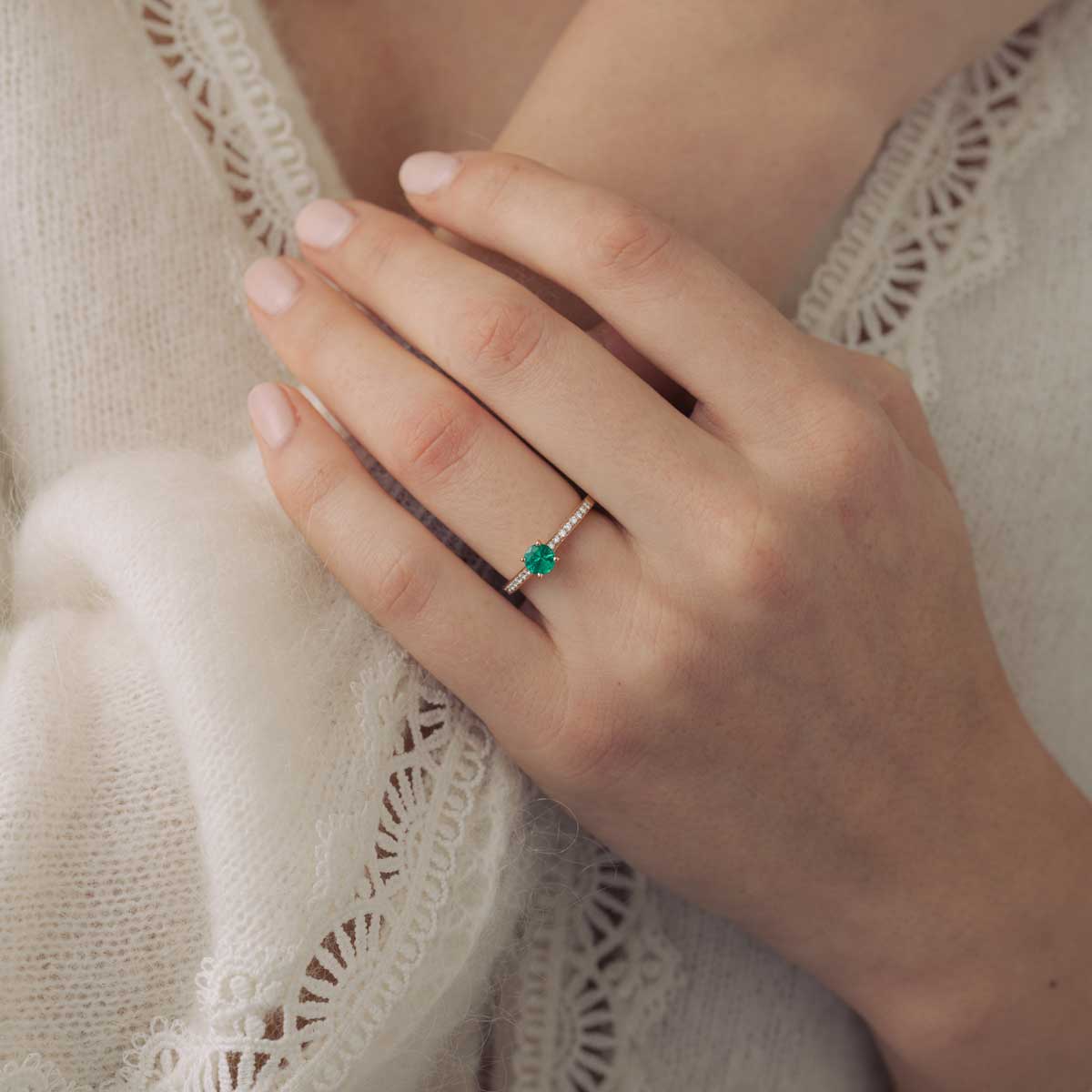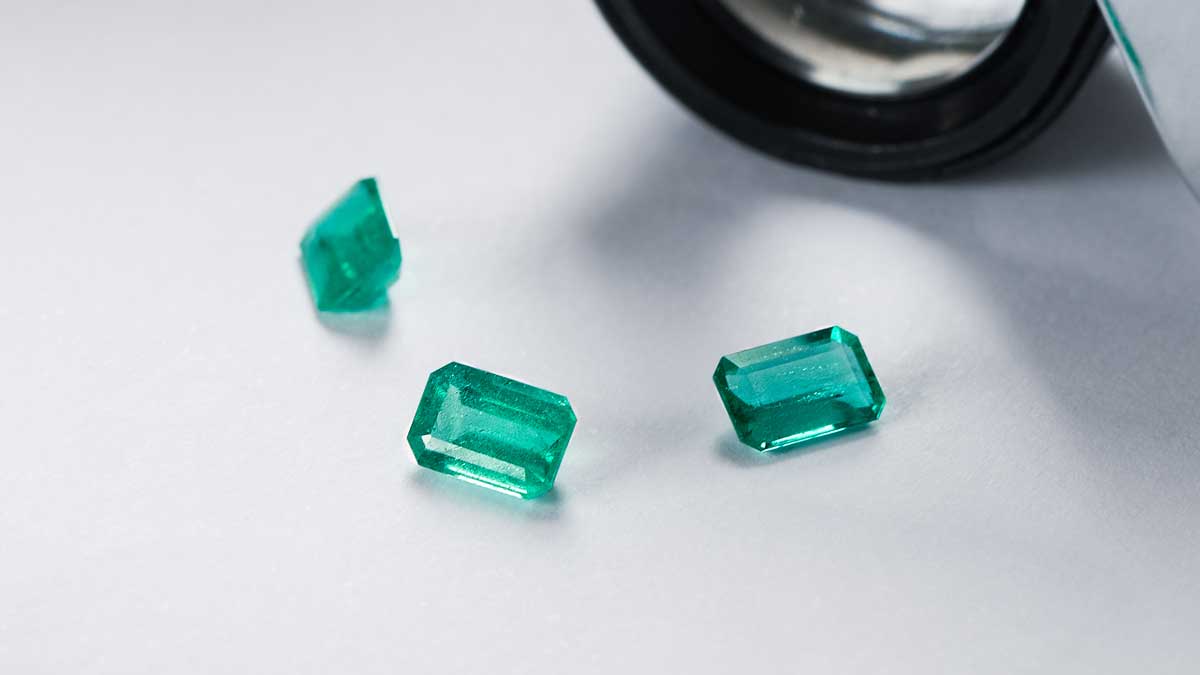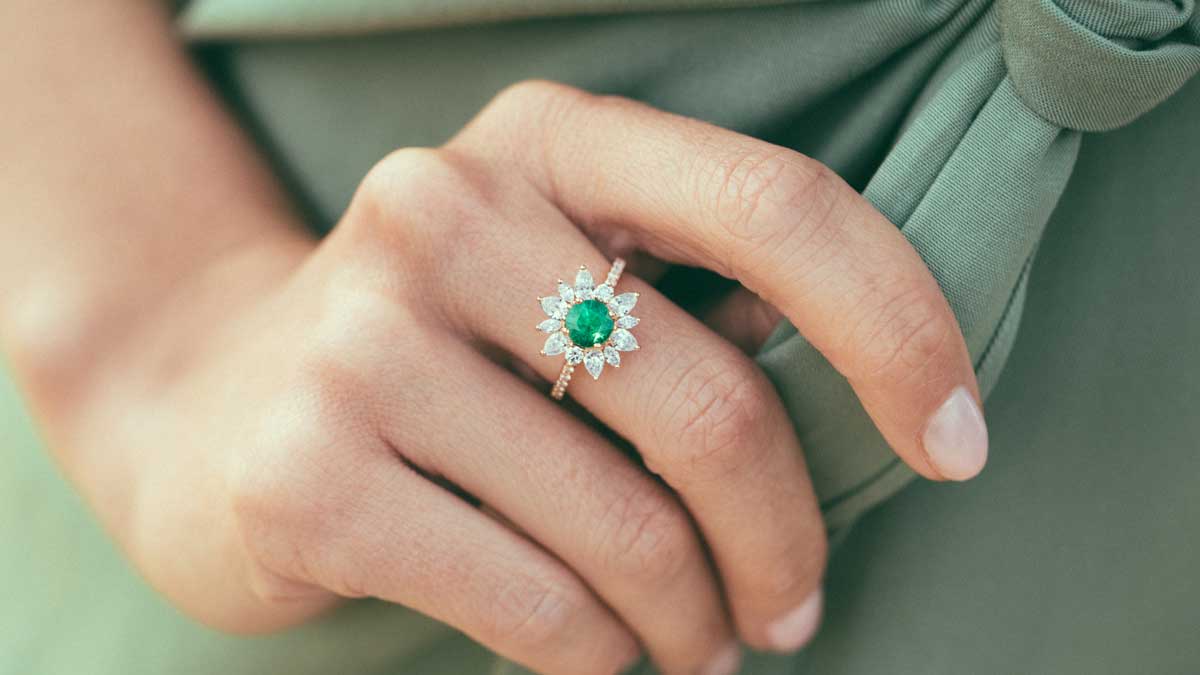Together with sapphire, ruby and diamond, emerald is one of the four precious stones and one of the most prestigious stones in the world of jewelry.
What makes the emerald such a sought-after stone? What are its main characteristics? Is it a suitable stone for everyday jewelry?
These are questions that you must certainly ask yourself and to answer them, we have created this guide for you!
Before getting to the heart of the matter, let's go back over its origins and history.

The history of emerald
From the Greek word Smaragdus, which means "green gemstone", emerald has been a sought-after jewel for thousands of years.
Cleopatra was the first well-known lover of emeralds. According to ancient texts, Egypt's greatest queen loved to wear this stone to enhance her legendary beauty, so that the emerald becamein Egypt... the queen of stones.
Whether in ancient Egypt, then at the court of the Ottoman Empire, at the court of the Mughal kings in India or in the Aztec Empire, the emerald has always been associated with kings and the notion of power.
Legend has it that on the day of his arrival in the New World, Hernan Cortés - the famous conquistador - was greeted by the Aztec king Montezuma with an emerald of spectacular beauty and size.
A symbol of renewal and spring because of its beautiful green color, the emerald was often presented as an offering to the dead or to the gods to bring eternal youth.
The origins of emerald
The main emerald mining locations today are in Russia, Zambia, Brazil and most famously in Colombia.
Colombian emeralds are undoubtedly the most prized emeralds for their exceptional colour and purity. The country is the world's largest producer, accounting for about half of the world's emerald production.
The green gold rush
The most famous emerald mine in the world is the Muzo mine, about 100 km from Bogota. Renowned for producing the purest emeralds in the world, it was already being exploited by the conquistadors in 1594!
It is notably from this mine that the largest emerald in history comes from: Unguentarium which weighs about 3 000 carats and which belongs today to the imperial treasure of Vienna.
Now that we have talked about its history, let's discuss emerald's main characteristics!
Main characteristics of emerald
Like aquamarine, emerald belongs to the beryl family. We can therefore say that these two stones are cousins! Its main characteristics are:

—— A miraculous existence
Emeralds are stones that should not exist. Indeed, their formation is the result of two theoretically incompatible elements: Chromium and Beryllium. The latter gives it its structure and Chromiumgives it its characteristic green colour - along with Vanadium and sometimes Iron.
Emeralds require extremely special - almost miraculous - geological, temperature and pressure conditions, and this is what makes them such an exceptional stone!
—— The stone that gave its name to a colour
The green of an emerald is a deep, balanced green, sometimes with shades of blue... totally unique.
This colour is so unique that the emerald has given its name to a colour. Emerald green is therefore an official colour in its own right, used in all areas.
Did you know that?
In addition to its name, emerald also refers to a form of stone.
The emerald cut refers to a rectangle-shaped cut with sloping corners - a rectangle with cut sides in the jargon.
This name comes from the fact that the emerald reveals its beauty particularly with this rectangular shape, which is natural for a beryl crystal.
Just like a pear-shaped, oval or round stone, there is an emerald-cut diamond, an emerald-cut aquamarine etc.

—— Relative fragility
A 7,5/10 on the Mohs scale, emerald is the least hard of the gemstones and thus the most fragile. It cannot be handled like a diamond or corundum - a sapphire or ruby - respectively at 10/10 and 9/10 on the same scale.
Rest assured, "fragile" does not mean that emerald will break as soon as it is touched! Perfectly suited to a piece of jewelry, it simply requires a little more care and above all vigilance to avoid knocks and bumps.
Where does this fragility come from?
Emerald is a stone which naturally has visible inclusions, as do many natural stones.
Inclusions refer to the presence of several external elements that have crept into the stone at the time of its formation.
What do the inclusions in an emerald look like?
Like a white veil inside the stone, inclusions are commonly referred to as "frosts" and in the case of emeralds the inclusion pattern is often described as 'jardin' (garden). This is quite normal and even contributes to the uniqueness of each stone, like a kind of fingerprint. Each emerald has its own inclusions, making each stone unique.
Naturally highly included, emeralds need a treatment to harden them and make them more suitable for jewelry.
What is this treatment?
The traditional treatment for emerald is a cedar oil bath. This oil is a natural, colourless, viscous and very sticky product that allows it to slip into the microscopic cracks of the stone and thus make it more resistant.
This technique is considered by the world's gemmological bodies as a natural and legal operation.. It has no impact on the price of an emerald, nor its value. On the contrary!
At Gemmyo, this is the only treatment that our emeralds undergo.
Note: Due to its particular structure, emerald is one of the few natural coloured stones that is not heated.. It would simply not withstand this treatment because, as we will see below, emeralds do not like heat very much...
Beyond these characteristics, emerald is also famous for its quality. What defines it ?
The quality of an emerald
—— AAA quality, the highest quality for a coloured stone
Unlike diamonds, colored stones do not have a standardised and internationally recognised system for comparing them.
That said, the certification of a coloured stone - such as an emerald - is just as rigorous as for a diamond and corresponds to three levels of quality:
-
A for medium and common quality.
-
AA for a rarer quality that is not especially used by large dealers but rather by small local lapidaries. It corresponds to a superior quality with few defects and pronounced colors.
-
AAA the best quality for coloured stones. It corresponds to a total absence of defects, a superior brilliance and pronounced and homogeneous colours.
How is this quality assessed for an emerald ?
Well, it is based directly on the 4 universal Cs used fordiamond certification! Namely:
-
Color: whether it is natural or enhanced by treatment.
-
Weight: the number of carats of the stone.
-
Cut or faceting: the evaluation of the quality of the stone's faceting and its shape.
-
Purity: the presence or absence of inclusions visible to the naked eye or x10 magnifying glass.
At Gemmyo, we certify that all our coloured stones are of AAA quality. This certification from our gemologists guarantees that you will choose a stone of excellent quality, perfectly cut and brilliant, among the most beautiful in circulation.
—— Our little extra: exceptional emeralds
As you may have noticed, for some of our models, we offer EXC emeralds, exceptional emeralds.
An exceptional emerald is a stone that is unusual in its great purity and is designated by our specialists as being of very high quality. These emeralds represent a very small part of the stones that our gemologists have the opportunity to select.
Please note that you have the possibility to choose an EXC emerald directly when you visit one of our boutiques.
FAQs
—— "Where do your emeralds come from?
At Gemmyo, all our emeralds come from Brazil! One of the most famous countries for the quality of its stones.
—— "Are emeralds rare?"
The emerald is a stone that is said to be "rare" because, as we have seen, it requires very particular conditions to form. This is why they are found in relatively specific areas - such as South America - which have all the geological conditions necessary for the birth of emeralds.
Like many stones, its purity, colour and size can vary its rarity and therefore its price significantly!
Therefore, the purer an emerald is, the rarer it is and the more expensive it is. Of all the stones, this point is probably the most verifiable for this stone which is naturally enclosed.
—— "Emeralds are fragile, what does that mean in practical terms for a piece of jewelry?"
As we have said, even though it is a relativement fragile compared to other gemstones, one should obviously not be afraid to wear an emerald!
Because of its characteristics, an emerald simply requires a little more vigilance to avoid shocks. Above all, emeralds are not heat resistant. So beware of strong temperature variations!
A concrete example from everyday life: putting your hand in an oven to retrieve a dish wearing an emerald ring is not a great idea!

—— "How to clean an emerald jewel?"
To clean an emerald jewel, nothing is easier. We advise you - as with all jewelry - to use a little warm soapy water and a soft bristle brush.
Please note: At Gemmyo, as with most of our colleagues, we offer professional cleaning in our boutiques. To do this, we use what is called an "ultrasonic tank" which thoroughly cleans a piece of jewelry and removes any dirt that may have crept under a stone.
This cleaning is strictly forbidden with an emerald jewel, as it could damage it due to the vibrations! So be careful if one of our colleagues offers you this cleaning for your emerald jewel.
To find all our tips on jewelry care, here is our complete guide.
—— "Which metal to associate with an emerald?"
Traditionally associated with yellow gold, emeralds also work well with rose or white gold.
Black gold on the other hand tends to dull the colour of the stone a little, but it can also bring a more original style.
If you want to emphasize and highlight its colour, combining it with whitegold or platinum will allow you to reveal the shine of your stone without distorting its colour.
—— "What is the occasion for giving an emerald?"
It is usually given as a gift to celebrate a 20th and 40th wedding anniversary! If you are looking foran anniversary gift, it is associated with the month of May and the astrological sign of Gemini.
Discover our emerald jewelry.
More specifically, discover our emerald engagement rings.
See all our precious stones.















